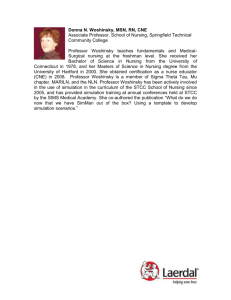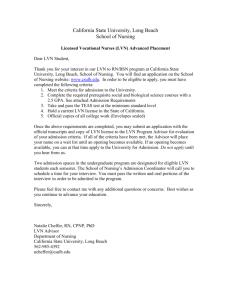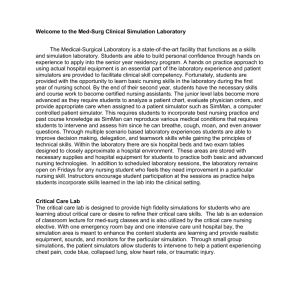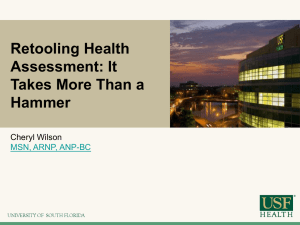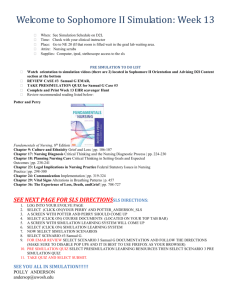NursingLicensedVocational_main_20110223_135040
advertisement
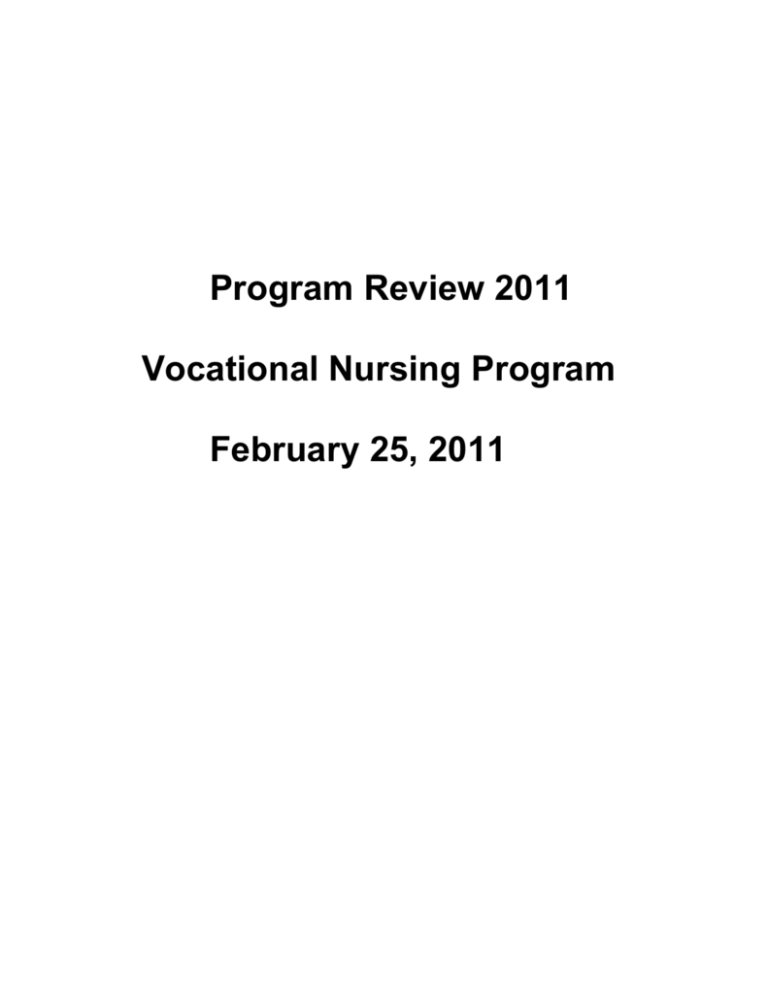
Program Review 2011 Vocational Nursing Program February 25, 2011 Annual Program Review Form 2010-11 The completion of this form is part of the institutional program review process. Please submit a completed form to the Program Review Committee and to your School Dean or immediate supervisor by February 25, 2011. Combined responses to questions 1 through 6 should not normally exceed four pages. Department: Contact Person: Date: Nursing -- Licensed Vocational Torres, Chita November 1, 2010 Please check this box to certify that faculty and staff in your unit discussed the major planning objectives: Description of Programs and Services and their Locations Home Health Aide/Nurse Assistant (VOCN 23, 24, 25) – Graduates of this 18 week full-time program will be highly qualified for entry-level positions as health care providers. They are qualified for positions in acute care and convalescent facilities as well as home care agencies and out-patient clinics. This program is approved by the California State Dept. of Health Services. Successful completion qualifies the graduate to take the Nurse Assistant Competency Exam and obtain State Certification to practice; obtain Home Health Aide Certification without further examination. This program is offered every semester at Southeast Campus - 1800 Oakdale Drive, S.F. (Credit Program) Licensed Vocational Nursing (LVN) – This three semester (18 months) Vocational Nursing Program prepares students for a career in vocational nursing. The program study for the certificate of completion in Vocational Nursing is designed to prepare students for employment in acute care facilities, clinics, long-term care facilities, physician’s offices, home care, and health centers. The program includes three levels of preparation representing the three full-time semesters of the program: VOCN 41 (14.5 units), VOCN 42 (15.5 units), and VOCN 43 (14.5 units). Critical thinking concepts and principles will serve as a framework for studying the nursing and behavioral sciences within a health promotion/risk reduction, multi-cultural based curriculum. This program is approved by the Board of Vocational Nursing and Psychiatric Technicians. The LVN program is located at John Adams Campus - 1860 Hayes St. S.F. 94117. (Credit Program) Geriatric Home Aide (Noncredit Program) – The Geriatric Home Aide program has been designed to prepare students to enter the home care field by providing job specific training for assistance to elderly persons in their homes. Total # of hours – 104. Home Health Aide (Noncredit) – VOCN 9194 and VOCN 9195 - This is a combination of theory and clinical practice that prepares student s to render home care to the adult and geriatric clients. This course is designed for re-entry students and those with Cantonese /Mandarin bilingual skills. Certification by the State of California is granted upon successful completion of theory and clinical components. This program is taught at Chinatown Campus. Licensed Vocational Nurse Refresher (VOCN 9200) - This noncredit course provides a comprehensive review of the principles of Licensed Vocational Nursing including a State Board Review program for students who already have a LVN or RN license re-entering the nursing workforce. This program is offered at John Adams Campus in collaboration with JVS/Welcome Back Center. Description from Spring 2010 inserted by Research & Planning. Please revise if necessary. 2 Use data on this and following pages to respond to Question 1: STUDENT CONTACTS, PERSONNEL, EXPENDITURES, AND PRODUCTIVITY Lice nce d V oca tiona l N ursing (7728,7730) FTES Regular Credit Enrollment Headcount Students FTES Regular Non- FTES CDCP credit Enrollment Headcount FTEF Instructional Credit FTEF NonInstructional Faculty Non- FTEF Instructional credit FTEF NonInstructional FTEF Chairs Other Personnel FTEF Administrator FTEF Classified Unrestricted 1000 Unrestricted 2000 Unrestricted 3000 Unrestricted 4000 Unrestricted 5000 Unrestricted 6000 Unrestricted 7000 Unrestricted Total Restricted 1000 Restricted 2000 Restricted 3000 Restricted 4000 Expenditures Restricted 5000 Restricted 6000 Restricted 7000 Restricted Total Other 1000 Other 2000 Other 3000 Other 4000 Other 5000 Other 6000 Other 7000 Other Total FTES per FTEF Credit Apportionment Credit ProductFTES per FTEF ivity NonApportionment Regular NC credit Apportionment CDCP Aca de mic Y e a r 2005-06 2006-07 2007-08 2008-09 2009-10 374.69 1,456 356 57.04 324.21 1,264 376 45.08 295.56 1,317 372 44.59 291.96 1,274 337 44.31 385.07 1,214 245 49.18 165 135 17.03 0.13 125 94 16.98 0.25 125 93 21.08 0.51 128 96 18.94 0.50 118 86 16.00 0.40 3.34 0.03 0.70 2.94 0.02 0.60 3.21 0.02 0.60 2.83 2.32 0.60 0.60 1.00 1.00 0.93 1.00 1.02 $1,227,106 $49,371 $262,191 $4,124 $157 $1,363,273 $74,896 $256,326 $1,884 $899 $1,445,584 $41,454 $268,131 $3,604 $702 $1,480,819 $46,479 $306,612 $3,700 $1,236,443 $51,880 $261,928 $972 $677 $1,542,950 $3,417 $1,697,278 $1,759,476 $1,837,610 $1,551,900 $14,799 $369 $855 $4,414 $378 $396 $427 $29,302 $1,070 $31,195 $200 $15,171 $304 $19,468 $40,832 $2,278 $63,548 $2,756 $450 $2,165 $10,200 $325 $21,593 $23 $86 $35 $352 $35 $5,371 22.00 $1,475,060 17.06 $133,042 $32,118 19.09 $1,356,638 15.35 $111,761 $108 14.02 $1,307,365 13.88 $117,081 $387 15.42 $1,352,507 15.65 $121,620 $35 24.07 $1,786,681 21.24 $135,002 3 STUDENT DEMOGRAPHICS IN CREDIT Lice nse d V oca tiona l N ursing Age Bogg Ethnicity Gender 16 - 19 20 - 24 25 - 29 30 - 34 35 - 39 40 - 49 50 Plus Unknown/No Response Received Bogg Fee Waiver Did Not Receive Bogg African American/Non Hispanic American Indian/Alaskan Native Asian (excluding SouthEast) Filipino Hispanic/Latino Other Non White Pacific Islander SouthEast Asian Unknown/No Response White Non Hispanic Female Male Unknown/No Response T ota l S tude nts 2005-06 0.8% 22.8% 20.5% 14.0% 13.5% 18.0% 10.4% 0.0% 52.0% 48.0% 20.8% 0.0% 19.9% 27.0% 14.6% 0.8% 1.1% 1.7% 1.4% 12.6% 78.7% 20.5% 0.8% 356 Aca de mic Y e a r 2006-07 2007-08 2008-09 1.6% 1.1% 0.9% 25.5% 22.0% 23.1% 22.3% 18.0% 21.4% 15.4% 12.1% 13.6% 10.4% 11.3% 10.4% 17.3% 20.2% 19.6% 7.4% 15.3% 10.4% 0.0% 0.0% 0.6% 54.8% 45.4% 47.8% 45.2% 54.6% 52.2% 13.3% 11.8% 12.8% 0.3% 0.0% 0.0% 21.5% 22.8% 18.7% 29.8% 31.7% 32.0% 15.4% 12.1% 10.1% 2.7% 2.2% 2.1% 1.1% 1.3% 0.9% 1.6% 2.4% 4.7% 4.0% 3.5% 7.7% 10.4% 12.1% 11.0% 80.3% 80.6% 80.7% 18.9% 18.5% 19.0% 0.8% 0.8% 0.3% 376 372 2009-10 1.2% 22.0% 26.9% 13.1% 9.8% 15.9% 11.0% 0.0% 61.2% 38.8% 15.1% 0.0% 24.9% 25.3% 11.4% 2.9% 1.2% 5.7% 2.4% 11.0% 78.8% 19.2% 2.0% 337 245 Aca de mic Y e a r 2006-07 2007-08 2008-09 1.1% 0.0% 0.0% 2.1% 2.2% 2.1% 5.3% 4.3% 4.2% 8.5% 7.5% 4.2% 7.4% 6.5% 8.3% 25.5% 21.5% 30.2% 45.7% 54.8% 43.8% 4.3% 3.2% 7.3% 0.0% 0.0% 0.0% 100.0% 100.0% 100.0% 6.4% 3.2% 2.1% 0.0% 0.0% 0.0% 61.7% 59.1% 62.5% 8.5% 6.5% 3.1% 6.4% 5.4% 8.3% 1.1% 2.2% 0.0% 1.1% 1.1% 0.0% 0.0% 0.0% 0.0% 10.6% 7.5% 9.4% 4.3% 15.1% 14.6% 83.0% 86.0% 88.5% 7.4% 10.8% 7.3% 9.6% 3.2% 4.2% 2009-10 0.0% 2.3% 4.7% 8.1% 15.1% 25.6% 40.7% 3.5% 0.0% 100.0% 3.5% 1.2% 57.0% 16.3% 1.2% 0.0% 0.0% 0.0% 8.1% 12.8% 88.4% 9.3% 2.3% STUDENT DEMOGRAPHICS IN NONCREDIT Lice nse d V oca tiona l N ursing Age Bogg Ethnicity Gender 16 - 19 20 - 24 25 - 29 30 - 34 35 - 39 40 - 49 50 Plus Unknown/No Response Received Bogg Fee Waiver Did Not Receive Bogg African American/Non Hispanic American Indian/Alaskan Native Asian (excluding SouthEast) Filipino Hispanic/Latino Other Non White Pacific Islander SouthEast Asian Unknown/No Response White Non Hispanic Female Male Unknown/No Response T ota l S tude nts 2005-06 0.0% 0.7% 2.2% 10.4% 6.7% 25.9% 51.1% 3.0% 1.5% 98.5% 0.7% 0.0% 63.7% 5.2% 5.2% 1.5% 0.0% 3.0% 9.6% 11.1% 85.2% 5.9% 8.9% 135 94 93 96 86 4 STUDENT SUCCESS IN CREDIT measured by GRADE POINT AVERAGE and PERCENT UNITS PASSED Lice nse d V oca tiona l N ursing Cre dit S ucce ss D a ta by D e mogra phic 2005-06 2006-07 2007-08 2008-09 2009-10 by Age 16 - 19 20 - 24 25 - 29 30 - 34 35 - 39 40 - 49 50 Plus Unknown/No Response 0.92 2.63 3.08 2.86 2.93 3.26 2.62 1.67 2.66 2.98 2.73 2.77 2.84 2.59 3.38 3.10 3.11 2.73 3.07 2.85 3.11 2.33 2.96 2.96 2.79 2.97 2.85 3.11 2.38 3.12 3.05 2.98 2.89 3.07 3.17 by Bogg Received Bogg Fee Waiver Did Not Receive Bogg 2.84 2.93 2.74 2.80 3.00 3.01 2.91 2.93 2.96 3.21 2.46 2.56 2.74 3.07 2.94 2.71 3.23 3.35 3.12 3.64 3.26 2.59 3.00 2.93 2.67 2.63 2.66 2.98 2.53 2.72 3.15 2.58 by E thnicity African American/Non Hispanic American Indian/Alaskan Native Asian (excluding SouthEast) Filipino Hispanic/Latino Other Non White Pacific Islander SouthEast Asian Unknown/No Response White Non Hispanic 3.09 2.99 2.78 2.83 2.63 2.96 3.42 3.31 2.90 2.84 2.92 3.15 3.18 2.89 2.89 3.38 3.15 3.01 2.99 2.89 2.76 2.86 3.32 3.47 by Ge nde r Female Male Unknown/No Response 2.84 3.02 3.50 2.75 2.84 2.44 3.00 3.03 2.74 2.93 2.85 3.85 3.03 3.13 3.19 by Age 16 - 19 20 - 24 25 - 29 30 - 34 35 - 39 40 - 49 50 Plus Unknown/No Response 33% 80% 96% 88% 80% 91% 80% 54% 75% 84% 82% 87% 86% 76% 50% 76% 92% 87% 98% 92% 89% 100% 89% 90% 89% 97% 88% 93% 100% 67% 95% 91% 98% 99% 95% 98% by Bogg Received Bogg Fee Waiver Did Not Receive Bogg 85% 87% 83% 78% 86% 89% 88% 93% 92% 99% 78% 79% 93% 87% 92% 86% 67% 75% 67% 100% 89% 71% 100% 92% 81% 77% 76% 100% 91% 64% 80% 75% by E thnicity African American/Non Hispanic American Indian/Alaskan Native Asian (excluding SouthEast) Filipino Hispanic/Latino Other Non White Pacific Islander SouthEast Asian Unknown/No Response White Non Hispanic 92% 88% 84% 83% 100% 89% 100% 90% 91% 96% 92% 100% 100% 93% 82% 87% 97% 93% 96% 94% 67% 92% 100% 97% by Ge nde r Female Male Unknown/No Response 85% 89% 100% 80% 83% 93% 88% 85% 67% 91% 88% 100% 94% 97% 100% Gra de P oint Ave ra ge P e rce nt U nits P a sse d 5 STUDENT SUCCESS IN NONCREDIT measured by ATTENDANCE HOURS Lice nse d V oca tiona l N ursing by Age by Bogg Atte nda nc e H ours by E thnicity by Ge nde r Atte nda nce H ours by D e mogra phic 2005-06 2006-07 2007-08 2008-09 2009-10 16 - 19 20 - 24 25 - 29 30 - 34 35 - 39 40 - 49 50 Plus Unknown/No Response 398.0 415.3 368.3 306.4 222.1 176.1 115.5 407.3 311.4 316.7 380.1 394.6 296.5 177.4 125.0 407.5 397.5 375.3 400.0 262.8 200.6 162.7 225.0 355.0 341.3 232.0 306.1 190.4 184.7 418.0 397.0 390.3 404.4 299.8 226.9 290.3 Received Bogg Fee Waiver Did Not Receive Bogg 401.0 219.1 251.7 251.7 242.3 300.2 African American/Non Hispanic American Indian/Alaskan Native Asian (excluding SouthEast) Filipino Hispanic/Latino Other Non White Pacific Islander SouthEast Asian Unknown/No Response White Non Hispanic 420.0 406.7 278.6 404.5 155.9 421.2 416.1 421.5 193.9 374.4 404.5 370.3 411.0 198.3 378.8 351.1 394.8 382.8 184.8 270.7 349.1 399.7 416.0 244.9 398.2 406.0 218.5 207.4 389.7 242.3 338.0 128.7 397.3 338.1 336.8 325.7 358.8 Female Male Unknown/No Response 222.5 254.7 193.0 266.5 136.6 213.1 258.5 258.4 48.0 257.6 137.1 101.3 298.2 336.5 231.5 6 1. Please provide reflections on the above data trends for your department. If you have additional data that you would like to provide, please also include that here. The students’ headcount for school year 2009 -2010 is less than the previous school years. This is due to the fact that the department is still two positions short of full-time faculty. We have limited our admission to the LVN program by about ten students per semester. For our C.N.A. program, we were able to maintain our admission numbers due to a Chancellor’s Grant funding ten (10) additional students for three semesters. Our programs are female dominated but we continue to see a rise in male population to both the LVN and C.N.A. programs. We also noticed that in school year 2009-2010, there is an increase in the number of students in the program that are in the age bracket of 20 – 29, while the older adult population maintain their steady numbers. In terms of ethnicity, the department continues to boast a very diverse group of students with a slight increase in African Americans and Latino population in last year’s data. 2. Please describe any internal or external developments affecting your department since the last program review. Despite having two new Tenure Track faculty this academic year, the department is still two (2) positions short of full-time instructors. Three of our faculty went on maternity leave posing a challenge to our ability to meet our staffing needs. The department resorted to Part-time position consolidation last semester to be able to get two (2) full-time tenure track positions for Fall 2011, approved by FPAC. This will enable us to have a full compliment of qualified faculty to provide consistency in the delivery of nursing education to our students. The LVN and C.N.A programs continue to have a large number of students wanting get in these programs. The LVN program uses the lottery system to take students in to the program. Through the efforts of the college’s Board of Trustees, students from San Francisco get a better chance in the lottery as their names are entered twice. Clinical placement for our nursing students particularly the Specialty Areas (Maternity, Pediatrics), has been a challenge. Not all acute care hospitals here in the bay area have Maternity and Pediatric units. There is a keen competition among nursing schools for these specialty units, and these specialty units will only take between 6-8 students per rotation. Since the Board of Vocational Nursing approved the use of simulation laboratory by 20% of students’ clinical time, we will be using the simulation lab to provide clinical teaching which may not otherwise be available in the hospital setting. Our C.N.A. program is located at Southeast campus. The room that they are using does not have a sink and water supply that they need when they are demonstrating basic nursing skills such as hand washing, bed bath, etc. Students and faculty have to go to the restroom to wash their hands and get water for their demonstration of certain skills. Southeast campus has a skills laboratory but is being used by another program. The C.N.A. program needs a skills laboratory that can provide the necessary space and equipments they need to teach effectively. 3. Summarize your department’s progress since the last program review on implementing your six-year plan for reviewing all courses, programs, projects, and services. Please also update the Excel spreadsheet that contains your timeline for this review and for the assessment of student learning outcomes. If your unit does not offer courses, use this space to discuss your plans for assessing your administrative unit outcomes. The department has completed updating VOCN 24 course outline, and approved by the Curriculum Committee Spring 2010. VOCN 23 and VOCN 25 course outlines have been updated and will be sent to the college’s curriculum committee for approval this semester. The department’s curriculum committee met on several occasions last Fall 2010 updating the course outlines for VOCN 42 and VOCN 43. They will be sent to Ms. Moriwaki, chair of curriculum committee for her review. We anticipate presenting these two course outlines to the college’s curriculum committee for their approval on their March/April meetings. On Flex day, the department’s curriculum committee met to discuss updating VOCN 41 A and B course outlines. Series of meetings are planned this semester to work on these two course outlines. 7 4. Summarize your department’s progress since the last program review on the plans for improvement in courses, programs, projects, and services based on the assessment of student learning outcomes. If your unit does not offer courses, use this space to discuss your progress in improving your services based on the assessment of your administrative unit outcomes. What is working particularly well? Are there items you need help with? Through Perkins grant funding, we have implemented last Fall 2010 the use of Northstar Learning software, a NCLEX –PN study aide for our students in all three levels. This software follows the NCLEXPN detailed test plan which is incorporated in the students’ course work. It also has a remediation program that includes standardized test that faculty implements as a tool to help students who are struggling academically. We also have replaced our outdated NCLEX –PN review software in our computer lab that allow students to practice taking the NCLEX-PN test in a stress-free environment, while making them more familiar with the Board of Vocational Nursing testing format. It is our hope that this endeavor will increase the NCLEX – PN pass rates of our graduates.The faculty had a series of staff development using these softwares, and training on how they will integrate and utilize the NCLEX – PN study aide in the nursing curriculum. Now that our simulation laboratory is in place, we anticipate its full use especially for our specialty areas (Maternity, Pediatrics). The lab simulates real life experiences for students in a controlled no –risk environment. By undertaking clinical work both in a simulation lab and in the field, every student has the opportunity to participate in the full range of essential practice experiences prior to graduation, making them competent practitioners. Sim lab also provides the opportunity for remedial training that significantly influence students’ success. The subcommittee recommended the need for an Early Alert system for our students who are struggling academically especially those with English as a second language. The department instituted an Early Alert system last Fall 2010. Students identified are counseled and offered tutorial during faculty’s office hours. The curriculum committee is also looking into the idea of offering Medical Terminology as a prerequisite to the program. 5. Summarize your progress to date on the major objectives you identified in last year’s program review (excluding progress already cited in #3 and #4). Faculty are now using the simulation laboratory as an adjunct to their clinical teaching. Despite the training of faculty with the use of the simulation lab, faculty recognized the need of a simulation laboratory technician to assist them with the maintenance and support of the simulation lab through out the academic year. Due to the department’s lack of adequate full-time and part-time staff this academic year, we have not addressed the plan of offering a part – time LVN program. It is my hope that once we stabilize our staffing issues in Fall 2011, we can proceed with looking at this matter. The LVN to RN Bridge program is a work in progress. The curriculum is in place. We need to find money to fund the program, and to continuously work with the RN program to support such endeavor. 6. What are the department’s major objectives for the 2011-12 academic year? Cite linkages, where applicable, to college plans. You may also cite linkages to the department’s review of courses, programs and assessment of student learning. We envision our simulation laboratory to be in full use by the three levels with the assistance of a simulation laboratory technician that will support and maintain the laboratory through out the school year. Professional development of faculty with the use of the simulation mannequins/softwares is critical in the implementation of the simulation laboratory. We purchased the simulation mannequins three years ago but were not fully used due to our being relocated to a different site for the renovation of John Adams. Faculty could use a refresher on how these mannequins work including the building of clinical scenarios on each level. 8 We have been successful in assisting our students in their completion of the LVN program however; we have not been successful in helping them with their desire to upgrade to become RNs. The LVN department would like to work collaboratively with the RN program to figure out ways to offer the LVN to RN Bridge program in the near future. This will allow past and present graduates of the LVN program pursue their long awaited nursing career ladder. Our students’ population is very diverse. They come to our program with a variety of educational, social and economic issues that affect their ability to complete the program in a timely manner. The program needs a case manager to assist students with their various needs so that they can be successful in the program, thereby decreasing our attrition rate and increasing the completion rates of our students. Bonus Question for 2010-11: What progress has your department / program made on the college-wide initiative to improve textbook affordability and access for all our students? Please indicate what discussions you have had and what strategies you have developed to combat the high cost of textbooks. The faculty is very much aware of the high cost of textbooks for our students. In our efforts to assist our students with regards to affordability of textbooks, we are using a textbook that combines Maternity, Pediatrics and Growth and Development rather than having three separate textbooks. For our Medical Surgical Nursing textbook, we use one textbook for the entire program (three semesters). For Community Health Nursing, students are made to use web based designed textbook as well as do research work rather than using a prescribed textbook. Faculty is also looking into the use of Kindle electronic reader which might be more cost effective for the students. 9 New Resources Needed Briefly describe each project. Include specific links, where applicable, to college plans to support your request. You may also include specific links to the department’s review of courses, programs and assessment of student learning. Please remember to include any costs associated with staffing, equipment, supply, facilities, or unit requests. If exact costs are unknown, please approximate. Put your projects in order of priority. Add additional items as necessary. First Priority X This is a new request We initially made this request in our Program Review Project Title: Hiring of a Simulation Lab Technician Brief Project Description: The LVN program through Perkins and Block monies acquired simulation mannequins, softwares,and an enclosed simulation laboratory with TV projection as an adjunct to clinical teaching. The simulation lab technician will support and maintain the simulation laboratory through out the school year. Fall 2011 Timeline: Rationale: Links to Plans: While the LVN faculty had previous training regarding the use of Simulation mannequins, they have expressed the need for a technician to support and maintain the simulation laboratory through out the academic year. The faculty is busy with students during the scheduled simulation activity, and immediately after their simulation activity, the faculty has either a class or has to go to the hospital for clinical work. Maintenance of the simulation lab is difficult without someone taking responsibility of the equipment and the laboratory itself. These equipments are expensive and hard to replace if they breakdown. Insert links here Staffing Needs: Simulation lab technician Equipment Needs: N/A Supply Needs: N/A Facility Needs: N/A Request for Additional Units: Second Priority X This is a new request We initially made this request in our Program Review Project Title: Offering an LVN to RN Bridge Program Brief Project Description: In collaboration with the RN program, a LVN to RN Bridge program will be offered to our LVN graduates. Fall 2012 Timeline: Rationale: Links to Plans: The LVN program completes about 75 students per year. Most of these students have the desire to upgrade themselves to become an RN. The RN program at City College is very impacted with hundreds of applicants. Having a LVN to RN Bridge program at the college allows past and present graduates of our LVN program the ability to pursue their quest to become a RN. Insert links here Staffing Needs: One full-time instructor Equipment Needs: 10 Supply Needs: Insert supply needs, if any, here Facility Needs: Insert facility needs, if any, here Request for Additional Units: Insert FTEF needs, if any, here Third Priority This is a new request X We initially made this request in our 2009 - 2010 Program Review Project Title: Case Manager for our Vocational Nursing Students Brief Project Description: A case manager for the LVN program to assist faculty in providing support services in a variety of ways to our students to help them be successful in their educational endeavor. As soon as fund becomes available Timeline: Rationale: Students come to our program with a variety of educational, social, economic issues that affect their ability to complete the program. The counselor for the program has a huge caseload besides our students which makes it hard for our students to get the one to one attention or follow up from the counselor. Having this Case Management service for our students can decrease the attrition rate and eventually increase the completion rates of our students. Links to Plans: Insert links here Staffing Needs: One full – time Case Manager Equipment Needs: 11
